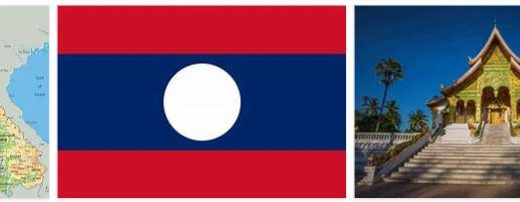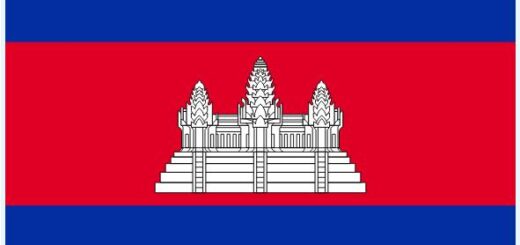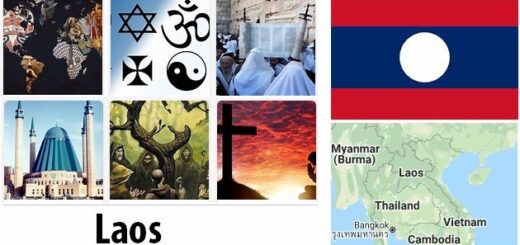Laos History
Historically, Laos is configured as a frontier mark, whose events have been conditioned by those of the major surrounding powers: also for this reason it is possible to speak of a Laotian political entity only starting from a relatively late epoch compared to the formation of historical cultures throughout the Indochinese peninsula. Until the middle of the century. XIV, the center of what would be the future kingdom of Laos, namely the region of Vientiane (Vieng Chan), suffered the alternation of Cambodian and Thai influences. Only the crisis of the Sukhōt’ai dynasty allowed the Laotian prince Fa Ngum, raised in Angkor under the influence of the Cambodian king whose son-in-law he was also, to lead a victorious expedition to the land of his fathers and to be crowned in 1353 in the city of Luang-Prabang (Luang P’ra Bang) king of Lan Ch’ang (the ” kingdom of a million elephants “). The son Un Hüon, husband of a Thai princess, promoted a census of the kingdom, the results of which led him to assume the title of P’ya Sam Sen T’ai (head of the three hundred thousand Thais); he enlarged and organized his own state, in which, however, the central powers remained very limited due to the existence of strong local autonomies. The sec. XV was characterized in its first part by a phase of development and a war with the northern Thai kingdom of Chiang Mai and, in its second part, by a long and dramatic war against the new Vietnamese Lê dynasty, to which the kingdom barely survived thanks to Thai support. After various events, which had seen among other things the Laotian kings annexing (by right of succession) the kingdom of Chiang Mai, in 1563 Setthath’irat brought the capital to Vientiane in order to better avail themselves of Thai and Vietnamese support in the fight against the Burmese which, throughout the second half of the century, repeatedly invaded and devastated the country.
The crisis ended in practice only with the consecration of Suliyavongsa, whose reign (1637-94), also characterized by a remarkable artistic renaissance, marked the apex of Laotian history. After his death the unity of the kingdom itself entered into crisis with the formation of two autonomous potentates in Luang-Prabang and Vientiane and, at the beginning of the century. XIX, also in Bassak (Champassak), in the south of the country. The sec. The eighteenth and the first half of the nineteenth therefore marked the progressive insertion of Laos in the area of Thai influence, until the French, already settled in Viet Nam, did not assert in their favor the Vietnamese rights on the eastern bank of the Mekong. Thanks above all to the work of A. Pavie, the country entered the orbit of French colonialism and in 1893 Siam (Thailand) recognized Laos as the French protectorate, destined to last until the Second World War, when the country was invaded by Japanese troops. The war and the Japanese invasion of Indochina threw the French colonial balance into crisis. Since the end of the conflict, Laos, which returned under French rule and formally reunified under the Luang-Prabang dynasty (Sisavang Vong, 1904-59; Savang Vatthana, 1959-75), was characterized by a double polarization of forces, at the same time. ideological and territorial. Prince Boun Oum Champassak represented the anti-Japanese resistance and, substantially, firstly pro-French and then pro-US; the three brothers of the princely family of Vientiane, Pethsarath, Souvanna Phouma and Souphanouvong were led by the forces in favor of a real independence of the country and a progressive evolution. In 1949 a new political and constitutional order, elaborated in agreement with France, was accepted by most of the Laotian politicians, but not by Souphanouvong and by the leaders of the ethnic minorities who, in connection with the Vietnamese resistance forces, waged the struggle armed. The Geneva Conference (1954) was responsible for developing a new formula of coexistence in the country with the participation, alongside the neutralists of Souvanna Phouma, of the Pathet Lao by Souphanouvong; but even this formula remained a dead letter and, while the Pathet Lao returned to the armed struggle, coups d’état organized by right-wing groups with US support followed one another in Vientiane. After years of guerrilla warfare, the 1961 Geneva Conference for Laos had no better luck, which was also followed by an agreement between the three princes, Souvanna Phouma, Souphanouvong and Boun Oum (representing the right); the guerrilla warfare, which had never completely ceased, resumed violently starting in 1963, and for a long time the Laotian events were intertwined with the wider phenomenon of the war in Viet Nam (in 1971 South Vietnamese and American troops intervened directly in Laos). Visit health-beauty-guides.com for Laos genuine and untouched.
Ephemeral compromise solutions were attempted in the years 1973-74, while in reality the guerrilla had been taking the form of a real civil war. Only in 1975, with the definitive victory of the Pathet Lao over the conservatives of Boun Oum and the neutralist Souvanna Phouma, was a stable political order reached, sanctioned in December of the same year by the fall of the Savang Vatthana monarchy and the proclamation of the People’s Democratic Republic of Laos, whose presidency was assumed by Souphanouvong. In the following years, while inside the Revolutionary People’s Party (PPR), led by Kaysone Phomvihane (at the same time prime minister), directed the reconstruction of the country, the foreign policy of Laos followed the lines of a privileged relationship with the USSR and Viet Nam (with the latter, a socialist republic born in 1976 from the reunification of the country, a twenty-five-year treaty of friendship was signed in 1977) and a correlative tension in relations with China. Only in the second half of the 1980s, while the activities of the armed opposition continued, did significant changes occur in the framework of both domestic and foreign politics. In 1986 the resignation of Souphanouvong led Phoumi Vongvichit to the presidency: during his mandate property rights were reintroduced into the legislation (1990) and diplomatic relations improved with both China, simultaneously with the realization of the withdrawal of the Vietnamese troops still present in Laos, and with Thailand.
In the’ August 1991 the Constitution was adopted confirming the political monopoly of the Popular Revolutionary Party (PPR). Among the first acts following the launch of the Constitutional Charter, the National Assembly elected the leader of the PPR, Kaysone Phomvihane, as head of state, who appointed Khamtai Siphandon as prime minister. With the collapse of the Soviet empire there was the suspension of all economic aid and a drastic decrease in bilateral trade between Laos and Russia. Not even the death of Kaysone Phomvihan (November 1992) caused excessive changes at the top of the regime, which found its new balance in the continuity ensured by the appointment of General Nouak Phoumsavan as President of the Republic, while the leadership of the party was assumed by Prime Minister Khamta himself. Siphandon. The only real signs of novelty in Laotian politics in the 1990s, also thanks to the complete withdrawal of the Vietnamese troops present in the country, were entrusted to a relative normalization of relations with China and Thailand. The cautious opening to the outside was achieved with the construction of the first bridge (“Bridge of Friendship”) between the Laotian and Thai banks of the Mekong (April 1994). Furthermore, in April 1995 the government signed an agreement with Viet Nam, Thailand and Cambodia for the economic development of the Mekong basin and for the common exploitation of its resources and in July 1997 Laos became part of the ASEAN, the association of Southeast Asian countries. Relations with the United States also tended to improve over time, so much so that they became – together with China, France and Australia – among the major foreign investors. The resistance opposed to any political innovation was however confirmed in 1996 when, to avoid a possible shock to the stability of the regime, the elderly head of state, Nouak Phoumsavan, was joined by a vice president in the person of General Sisavath Keobouphanh. General Khamtai Siphandon was elected president of the Republic in 1998 by the National Assembly, who appointed General Sisavath Keobouphanh as prime minister. In 2001 the European Union passed a resolution that imposed political conditions regarding the future of Laos; in 2002 Siphandon was re-elected president and a law was passed that provided for the death penalty for drug-related crimes. In the legislative elections of April 2006, the Revolutionary People’s Party won 113 of the 115 seats available. The parliament elected Communist Party leader Choummaly Sayasone as president and Bouasone Bouphavanh as prime minister. In 2010 Thongsing Thammavong became premier, while in 2011 Sayasone was reconfirmed for another 5 years.



